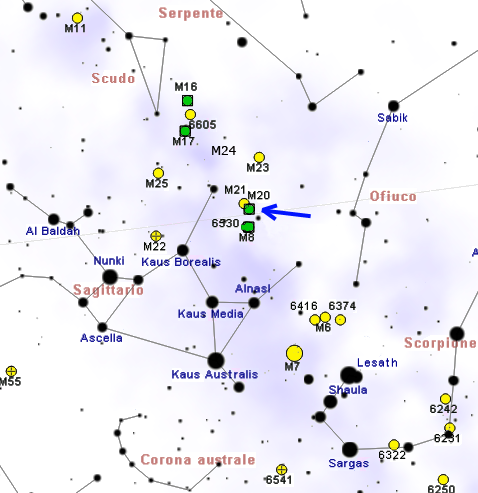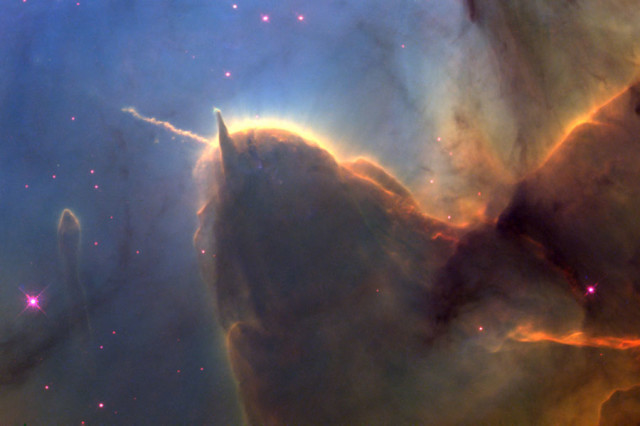The Trifid Nebula, also known as Messier 20 (M20), is a large star-forming region located in the southern constellation Sagittarius.
The nebula’s name means “divided into three lobes,” and refers to the object consisting of three types of nebulae and an open star cluster. The open cluster is surrounded by an emission nebula, a reflection nebula, and a dark nebula within the emission nebula that gives M20 the trifurcated appearance for which it is known.
The dark nebula was catalogued by Edward Barnard and has the designation Barnard 85 (B85). The Trifid Nebula has the designation NGC 6514 in the New General Catalogue.
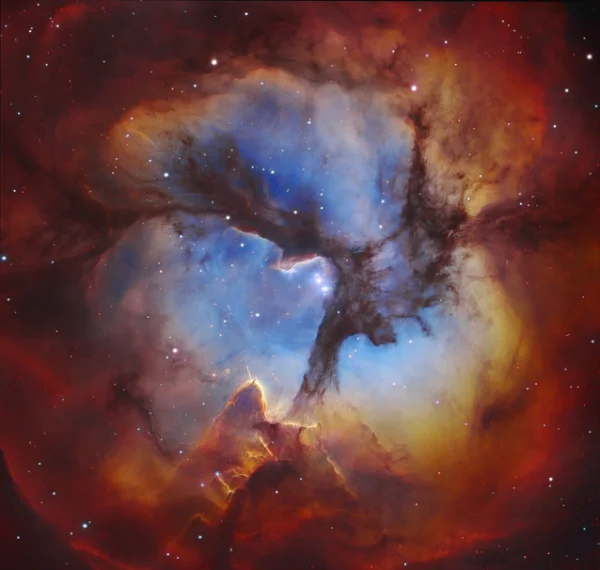
The central region of the Trifid Nebula (M20). Image: Subaru Telescope (NAOJ), Hubble Space Telescope, Martin Pugh; Processing: Robert Gendler
Messier 20 is a popular object among amateur astronomers because it is quite bright and easily observed in small telescopes. It has a diameter of 42 light years and lies at a distance of 5,200 light years from Earth.
M20 has an apparent magnitude of 6.3 (a magnitude of 9.0 is sometimes given) and can be seen in binoculars, but is best observed in larger telescopes.
In the northern hemisphere, the nebula is best seen in the summer months, when Sagittarius climbs higher in the sky.
The Trifid Nebula lies only 2 degrees to the northwest of the larger Lagoon Nebula (Messier 8), another famous deep sky object in Sagittarius. It is even closer to Messier 21, an open cluster of stars located only 0.75 degrees to the northeast of M20.
For observers in the northern hemisphere, the best time of year to observe the Trifid Nebula is from spring to early fall. In the summer months, Sagittarius is highest in the sky around midnight or 1 am on July 1, around 10 or 11 pm on August , and around 8 or 9 pm on September 1.
The easiest way to find the Trifid Nebula is to start from the Teapot asterism in Sagittarius and find the tip star, Kaus Borealis (Lambda Sagittarii). With an apparent magnitude of 2.82, Kaus Borealis is bright enough to be seen without binoculars. Following the line from the star northwest toward the Lagoon Nebula leads to the optical binary 7 Sagittarii. The bright cluster of stars embedded within the Trifid Nebula lies about 2 degrees north. The smaller compact cluster to the northeast of M20 is M21.
In binoculars, the nebula appears as a fuzzy circular patch. Small telescopes (80 mm or 3.1-inch) reveal the dark dust lanes. Larger telescopes (150 mm or 6-inch) show the Trifid Nebula’s irregular shape and the three dark lanes spreading from the nebula’s central region.
The Trifid Nebula has an estimated age of only 300,000 years, which makes it one of the youngest emission nebulae known.
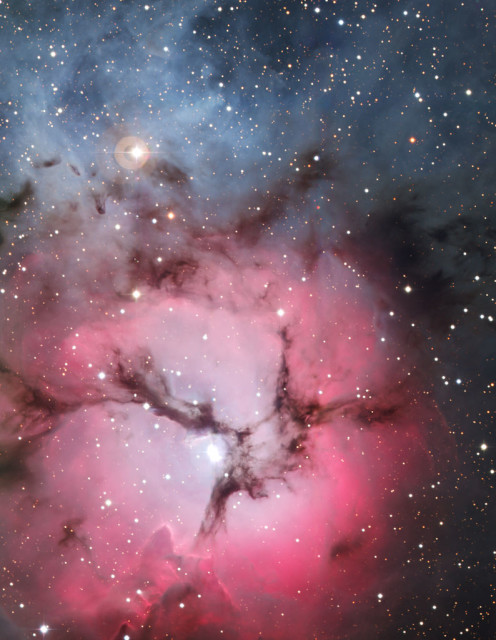
The massive star factory known as the Trifid Nebula was captured in all its glory with the Wide-Field Imager camera attached to the MPG/ESO 2.2-metre telescope at ESO’s La Silla Observatory in northern Chile. So named for the dark dust bands that trisect its glowing heart, the Trifid Nebula is a rare combination of three nebulae types that reveal the fury of freshly formed stars and point to more star birth in the future. The field of view of the image is approximately 13 x 17 arcminutes. Image: ESO
The bright open cluster lies at the core of the emission nebula and is partly obscured by thick dust lanes which block visible light and conceal parts of the nebula’s central region. In images, the dust lanes are silhouetted against the brighter nebula in the background.
The emission nebula is illuminated by the light of the young, hot, massive class O stars that form the open cluster.
The young stars include a triple star system known as ADS 10991, whose primary component belongs to the spectral class O5 or O6 and has a visual magnitude of 7.6. The bright stars within the nebula make estimates for brightness difficult, which is why some astronomers give a magnitude of 6.3 and others, 9.0.
The stars’ intense radiation has blown away the dust and gas in the region surrounding the cluster. As a result, there is no star forming activity occurring in the vicinity of the cluster anymore.
The reflection nebula seen to the north is not physically associated with M20, but merely appears along the same line of sight.
Facts
The Trifid Nebula was discovered by Charles Messier on June 5, 1764. He described the object as a „cluster of stars, a little above the Ecliptic, between the bow of Sagittarius and the right foot of Ophiuchus.“ Messier discovered M21 the same day.
William Herschel gave the nebula four different numbers when he included it in his catalogue in the 1780s: H IV.41, H V.10, H V.11, and H V.12.
John Herschel was the one to name the nebula Trifid after observing the dark dust lanes that separate it into three lobes.
Observations using NASA’s Spitzer Space Telescope in January 2005 resulted in a discovery of 30 massive embryonic stars and another 120 smaller newly formed stars not previously seen in visible light images.
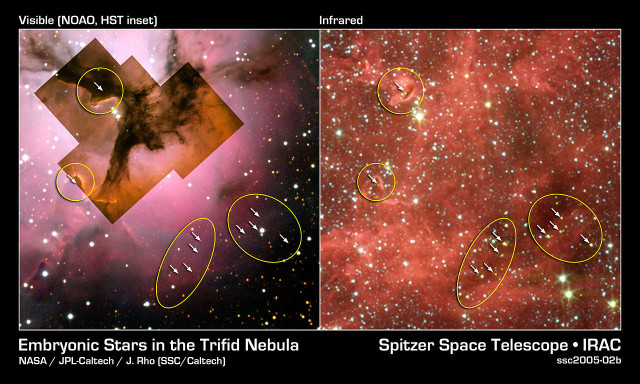
This image composite compares visible-light views with an infrared view from NASA’s Spitzer Space Telescope of the glowing Trifid Nebula, a giant star-forming cloud of gas and dust located 5,400 light-years away in the constellation Sagittarius. Visible-light images of the Trifid taken with NASA’s Hubble Space Telescope, Baltimore, Md. (inside left) and the National Optical Astronomy Observatory, Tucson, Ariz., (outside left) show a murky cloud lined with dark trails of dust. Data of this same region from the Institute for Radioastronomy millimeter telescope in Spain revealed four dense knots, or cores, of dust (outlined by yellow circles), which are “incubators” for embryonic stars. Astronomers thought these cores were not yet ripe for stars, until Spitzer spotted the warmth of rapidly growing massive embryos tucked inside. These embryos are indicated with arrows in the false-color Spitzer picture (right), taken by the telescope’s infrared array camera. The same embryos cannot be seen in the visible-light pictures (left). Spitzer found clusters of embryos in two of the cores and only single embryos in the other two. This is one of the first times that multiple embryos have been observed in individual cores at this early stage of stellar development. Image: NASA/JPL-Caltech/J. Rho (SSC/Caltech)
The stars are scattered throughout the Trifid Nebula’s bright clouds and dark lanes of dust. The cloud containing the embryonic stars lies about 8 light years away from the central star of M20.
The cloud has a stellar jet about 0.75 light years in length emanating from a young star embedded within the stellar nursery. The jet is illuminated by M20’s central star. To the right of the jet, images of the Trifid Nebula reveal a stalk pointing from the thick cloud to the central star. The stalk is dense enough not to be blown away by the star’s radiation. It is an example of evaporating gaseous globules, or EGGs, which have also been imaged by the Hubble Space Telescope in the Eagle Nebula (Messier 16), located in Serpens constellation.
The Trifid Nebula is often mentioned in works of science fiction, including Beast Wars, a series set in the Transformers universe and the Star Trek original series episode “The Alternative Factor,” in which M20 is a portal between two universes.
Trifid Nebula – Messier 20
Constellation: Sagittarius
Coordinates: 18h 02m 23s (right ascension), -23°01’48” (declination)
Visual magnitude: 6.3 (9.0)
Apparent dimensions: 28 arcminutes
Radius: 21 light years
Distance: 5,200 light years (1,600 parsecs)
Age: 300,000 years
Designations: Trifid Nebula, Messier 20, M20, NGC 6514, Gum 76, Sharpless 30, RCW 147
Images
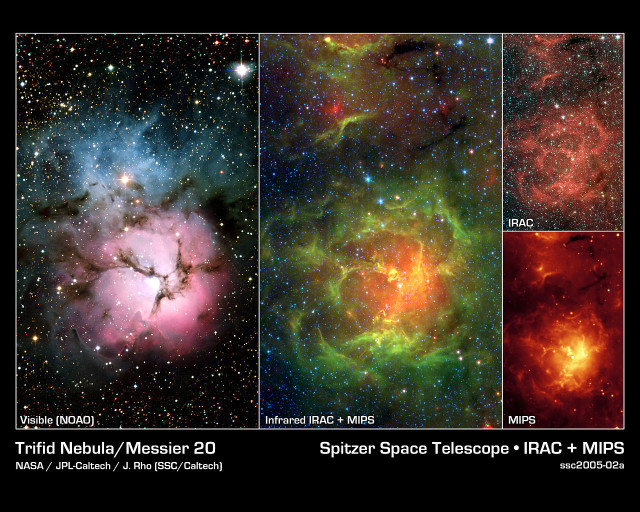
This image composite compares the well-known visible-light picture of the glowing Trifid Nebula (left panel) with infrared views from NASA’s Spitzer Space Telescope (remaining three panels). The Trifid Nebula is a giant star-forming cloud of gas and dust located 5,400 light-years away in the constellation Sagittarius. The false-color Spitzer images reveal a different side of the Trifid Nebula. Where dark lanes of dust are visible trisecting the nebula in the visible-light picture, bright regions of star-forming activity are seen in the Spitzer pictures. All together, Spitzer uncovered 30 massive embryonic stars and 120 smaller newborn stars throughout the Trifid Nebula, in both its dark lanes and luminous clouds. These stars are visible in all the Spitzer images, mainly as yellow or red spots. Embryonic stars are developing stars about to burst into existence. Ten of the 30 massive embryos discovered by Spitzer were found in four dark cores, or stellar “incubators,” where stars are born. Astronomers using data from the Institute of Radioastronomy millimeter telescope in Spain had previously identified these cores but thought they were not quite ripe for stars. Spitzer’s highly sensitive infrared eyes were able to penetrate all four cores to reveal rapidly growing embryos. Astronomers can actually count the individual embryos tucked inside the cores by looking closely at the Spitzer image taken by its infrared array camera (top right). This instrument has the highest spatial resolution of Spitzer’s imaging cameras. The Spitzer image from the multiband imaging photometer (bottom right), on the other hand, specializes in detecting cooler materials. Its view highlights the relatively cool core material falling onto the Trifid’s growing embryos. The middle panel is a combination of Spitzer data from both of these instruments. The embryos are thought to have been triggered by a massive “type O” star, which can be seen as a white spot at the center of the nebula in all four images. Type O stars are the most massive stars, ending their brief lives in supernovas. The small newborn stars probably arose at the same time as the O star, and from the same original cloud of gas and dust. The Spitzer infrared array camera image is a three-color composite of invisible light, showing emissions from wavelengths of 3.6 microns (blue), 4.5 microns (green), 5.8 and 8.0 microns (red). The Spitzer multiband imaging photometer image shows 24-micron emissions. The Spitzer mosaic image combines data from these pictures, showing light of 4.5 microns (blue), 8.0 microns (green) and 24 microns (red). The visible-light image is from the National Optical Astronomy Observatory, Tucson, Ariz. Image: NASA/JPL-Caltech/J. Rho (SSC/Caltech)
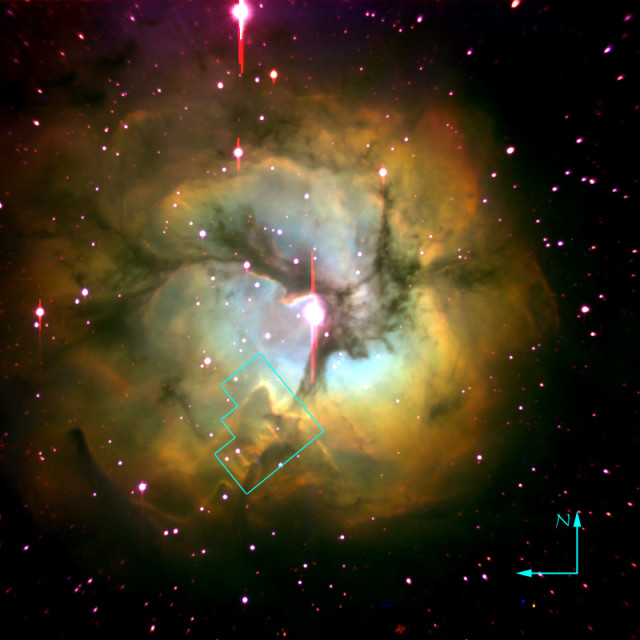
The Trifid nebula (M20, NGC NGC 6514) in pseudocolor. Image taken with the Palomar 1.5-m telescope. The field of view is 16’ ´ 16’. Red shows [S II] ll 6717+6731. Green shows Ha l 6563. Blue shows [O III] l 5007. The WFPC2 field of view is indicated. Image: Jeff Hester (Arizona State University), Palomar telescope.
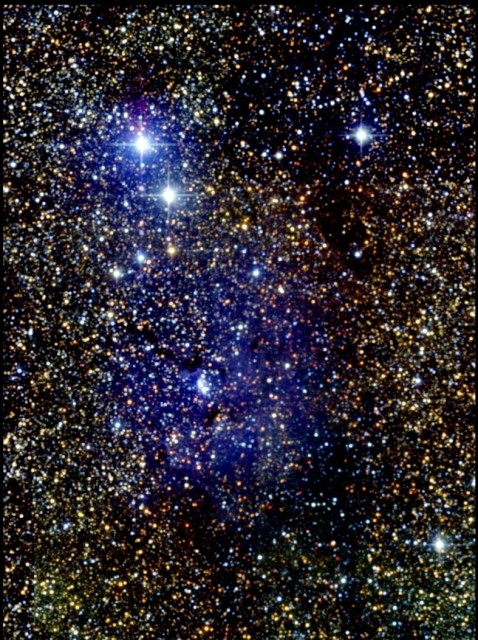
Messier 20: The Trifid Nebula. Image: Two Micron All Sky Survey (2MASS), a joint project of the University of Massachusetts and the Infrared Processing and Analysis Center/California Institute of Technology, funded by the National Aeronautics and Space Administration and the National Science Foundation.
